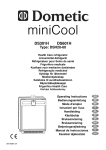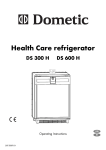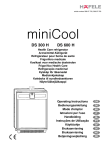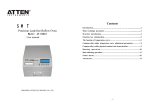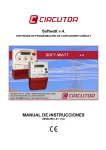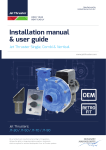Download Service Manual
Transcript
Service Manual DS301H DS601H Absorption Refrigerators for Storing Pharmaceutical Products Publication number :599720783 Table of Contents: 1. The appliance ............................................................................ 3 1.1. Specifications............................................................................. 3 1.2. Warning! .................................................................................... 3 1.3. Spare parts, electrical wiring diagram ........................................ 3 2. Installation and repair operations ............................................... 4 2.1. Tools .......................................................................................... 4 2.2. Cabinet, door ............................................................................. 5 2.2.1. Adjusting right and left-hand swing door .................................... 5 2.2.2. Replacing lock ......................................................................... ..7 2.2.3. Replacing door panel ............................................................... ..8 2.2.4. Mounting and dismounting the handle ..................................... 9 2.3. Electrical component................................................................ 10 2.3.1. Operation ................................................................................. 10 2.3.1.1 Specifications........................................................................... 10 2.3.1.2 Operation of built-in safety features ......................................... 10 2.3.1.3 Self-test.................................................................................... 10 2.3.2. Installation................................................................................ 11 2.3.2.1 Replacing the elements under the light cover .......................... 11 2.3.2.1.1 Replacing built-in optical sensor .............................................. 11 2.3.2.1.2.1 Replacing fan (until prod.date 28.02.2009) .............................. 12 2.3.2.1.2.2 Replacing fan (from prod.date 28.02.2009) ............................. 13 2.3.2.2 Testing and replacing the parts connecting to the control electronics PCB ................................................ 13 2.3.2.2.1 Testing assambled thermal fuse .............................................. 14 2.3.2.2.2.1 Replacing temperature sensor (until prod date:11.02.2009) ....15 2.3.2.2.2.2 Replacing temperature sensor (from prod.date:11.02.2009)....16 2.3.2.2.3 Replacing heating element ..................................................... 16 2.3.2.2.4 Replacing main cable.............................................................. 19 2.3.2.2.5 Replacing Buzzer.................................................................... 19 2.4. Cooling aggregate................................................................... 19 2.4.1. Replacing thermo fuse ............................................................ 20 2.5 Electrical wiring diagram ......................................................... 20 2 1. The appliance 1.1. Specifications The appliance is a free-standing, fluid absorption cooling system refrigerator for the storage of pharmaceutical products, with a capacity of 30 or 60 liters. The temperature of the internal container is maintained at a value between +2°C and +8°C by the automatic thermoregulator at an environmental temperature between +10°C and +32°C. The appliance is furnished with integrated electronic control, including the control of interior temperature as well as fan and light control. 1.2. Warning! - Do not repair or clean the appliance with the power supply cord plugged in! The appliance may only be operated by adults! All instructions in the operating manual must be followed when operating the appliance! Any repair or service of the appliance that involves disassembling electrical parts may be carried out by authorized service technicians only! Certain parts of the aggregate remain hot for a while after shutdown; service must be carried out with caution! After any repair that involves disrupting the electrical circuit, an electrical insulation resistance test must be carried out at all times! (see 2.3.2.2) Only appliances with compliance qualifications may be connected to the mains! It is recommended to wear protective gloves for operations with possible hand injuries! In order to avoid damage to the appliance, the cabinet must be placed on a soft padding (felt, sponge) 1.3. Spare parts, electrical wiring diagram The lists of spare parts and electrical wiring diagrams by Product numbers can be found on the web page http://www.electrolux-ti.com. Attention! Any parts that need to be replaced during repair may only be replaced by parts identical to the originals and which were chosen based on the list of spare parts! Using parts other than original DOMETIC parts will result in lost warranty. 3 2. Installation and repair operations 2.1. Tools Recommended tools: Figure 1 - Universal pliers 160-mm, 2 pc. - Magnetic screwdriver handle - Pz 1 fitting-strip - TX10 fitting-strip - TX15 fitting-strip - TX20 fitting-strip - Special bit marked TX 15 (see Figure 6) - Standard screwdriver 120 * 5 - Standard screwdriver 100 * 4 - 1000-V electrical insulation resistance meter - Electrical break-detecting device 4 2.2. Cabinet, door 2.1.1. Adjusting right and left-hand swing door - Lay refrigerator on its aggregate unit side Loosen up foot-frame’s screws (7 pc), remove foot-frame. 2 pcs out of these have specially designed slots. (Fig. 2, 3, 4, 5, 6) Figure 2 - Figure 4 Figure 5 Place refrigerator in upright position on workbench, open cabinet door to 180 degrees Snap out the fixing tab of the upper hinge pin by the help of a screwdriver and push out the pin, carefully, so that the door does not fall off. (Fig. 7, 8) Figure 6 - Figure 3 Figure 7 Figure 8 Lift off door from bottom hinge pin, remove hinge washer (Fig. 9) Figure 9 - Remove bottom hinge pin and lower and upper hinge plug in the same way as in case of the upper hinge pin Install bottom hinge pin on opposite side, snap in place. (Fig. 10) Figure 10 5 Pull spacer on bottom hinge pin, then place door on hinge pin. (Fig. 11, 12) Figure 11 - Figure 12 Snap in upper hinge pin lower and upper hinge plug. (Fig. 13) Figure 13 - Lay refrigerator on aggregate unit casing Lead feed cable through foot-frame. (Fig. 14) Figure 14 - Attach grooves of foot-frame and aggregate unit casing, position footframe, secure with 7 screws. (Fig. 15, 16) Figure 15 - Figure 16 Place refrigerator in upright position, make sure of unhindered operation of the door and complete sealing. 6 2.2.2. Replacing lock - Open refrigerator door Pull key from the lock, remove lock cover from rosette using 2 standard screwdrivers. (Fig. 17) Figure 17 - Remove mounting screws from forehead panel, remove forehead panel by slightly pulling.( Fig. 18, 19) Figure 18 - Figure 19 Remove locking plugs from bores of lock mounting screw. (Fig. 20) Loosen and remove lock mounting screws. (Fig. 21) Figure 20 Figure 21 7 - Lift out lock. (Fig. 22) Detach lock mounting plate from rosette using 2 standard screwdrivers, place on new lock. (Fig. 23) Figure 22 - Figure 23 Reassembly is done in reverse order Test locking - opening, adjust locking plate as necessary. (Fig. 24) Figure 24 2.2.3. Replacing door panel - Remove mounting screw of forehead panel and lock cover. (see 2.2.2.) Slightly pull forehead panel, remove Pull out door panel from groove of doorframe, facilitating the pull by slightly bending the door panel Insert new door panel (max. panel thickness 2 mm) into door, push in place. (Fig. 25) Figure 25 - Reinsert forehead panel, secure with screws Push lock cover in place. 8 2.2.4. Mounting and dismounting the handle Handle as option is available. How to mount and dismount the handle: The handle can be found in accessories or it can be ordered as an options. It can be mount and unmount according to the following instruction. Mounting: - Pick the handle hole cover from the forehead panel. Take care not to damage the part. (Fig. 26, 27) Figure 26 - Figure 27 Place stud of the handle into the slot of forehead panel. (Figure 28) Figure 29 Figure 28 - Turn the handle into direction of final position, place the locating pin of the handle into the groove of the forehead panel, and snap the claw placed at end of the handle into edge of the door (Fig. 29). Dismounting: - Press together the door and the forehead panel by one of your hand and unhook the claw from edge of the door by the other one, and hold away a little bit. (Fig. 30) Figure 30 Figure 31 Take off the handle from the slot by turning it out, (Fig 31) 9 2.3. Electrical component 2.3.1. Operation 2.3.1.1. Specifications The appliance is furnished with integrated electronic control. The electronics include the control of interior temperature, the control of the built-in fan and light, and supervises the door (signals when left open), in which case it warns the user with a beep sound. The lighting unit consists of 2 pcs of LED light sources, which, along with lighting the interior, also indicates the result of the self-test executed by the electronics when voltage is applied to the appliance. The switching of the light is controlled by an infrared optical sensor operated by the door. Temperature control of the internal container is performed automatically. A thermal fuse is also fitted in the electrical circuit to prevent the aggregate from overheating. Should it detect any malfunctions during self-test, the electronics shuts down the appliance and the lighting LEDs start blinking continuously. If you encounter this, make sure that the appliance is not overloaded, that it is level, that the door was closed, and that the ventilation of the cooling unit is appropriate. If you find these in order, unplug the appliance from the wall socket for at least 10 seconds, then re-plug it in the mains. The appliance then initiates basic status and starts operating. 2.3.1.2. Operation of built-in safety features. Open door warning: This omits a beep sound, warning the user to close the door. 20 seconds after opening the door there is an interrupted sound. (1Hz) 1 minute from opening the door the interrupted beep sound is faster. (2Hz) Fan failure warning The fan secures the circulation of air inside the refrigerator. It operates when the door is closed and stops when the door is opened. Door opening and closing are signaled to the control electronics by the optical sensor. It warns the user with a beep sound if the fan should stop (failure) while the door is closed. The control electronics checks potential fan failure every 20 seconds. In case of error, the buzzer provides a continuous beep sound. 2.3.1.3. Self-test When plugging in the appliance, the built-in electronics performs a self-test. The system checks the status of the peripheries. The result is indicated by the varying number of flashes of the illuminating LED’s (0.5Hz). The evaluation is contained in the table below. Number of flashes N=0 N=1 Error status General error Diagnosis O.K. Upon detecting failures (thermal sensor failure, control panel failure) the LEDs flash continuously at a higher frequency. 10 If no error is detected by the electronics (one flash) then, after two seconds it turns on the feed voltage for the heating element, and the normal, regulated operation begins. 2.3.2. Installation: The electrical component of the appliance is divided between two major connection points: 1. The lighting panel under the light cover, with fan. 2. Control electronics PCB under the electrical cover 2.3.2.1. Replacing the elements under the light cover - Unscrew cover mounting screw.( Fig. 32) Snap out the light cover by slightly pulling it forward.( Fig. 33) Figure 32 - Figure 33 Snap out lighting panel by pushing the locking tab aside.( Fig. 34, 35) Figure 36 Figure 35 - Figure 34 When replacing the panel, pull off the PCB (printed circuit board) connections from the faulty panel, push back on the new panel to the same position (according to wiring diagram). Snap lighting panel back in light casing.(Fig. 36) 2.3.2.1.1. Replacing built-in optical sensor - Pull off PCB connection from lighting panel Slightly pressing with fingertips the button-head ends of the sensor elements, push out the sensor from its casing, hold it by its wire end, remove (Fig. 37) - Insert new sensor in the casing, push in place with fingernails. (Fig. 38) - Push PCB connection onto panel 11 Figure 37 - Figure 38 Upon finishing the actions, snap lighting panel back into its casing, adjust wires Insert light cover in groove of inner chamber, snap in. (Fig. 33) Screw back mounting screw of lighting cover. (Fig. 32) Testing of electrical insulation resistance is not necessary after disrupting this electrical part. After finishing the installation, connect the appliance to the mains, and check its operation based on the self-test by the electronics. (see 2.3.1.3.) 2.3.2.1.2.1 Replacing fan (Until prod. date 11.02.2009.) - Remove light cover. (see 2.3.2.1.) Pull fan PCB connector off lighting panel Remove thermal sensor from fan casing. (Fig. 39) Screw off fan casing, remove it from interior chamber.(Fig. 40) Figure 39 - Figure 40 Place thermal sensor in fan casing.(Fig. 41) Screw back on fan casing, checking the positions of fan wire and plastic duct. (Fig. 42) Connect fan PCB connector to lighting panel. Remount light cover. (see 2.3.2.1.) Figure 41 12 Figure 42 - Make sure that the fan operates appropriately. To check this, connect appliance to the mains, open door and cover the optical sensor. Now the fan should be operating. (Fig43) Figure 43 - In each case after disrupting the electrical circuit, test electrical insulation resistance (with a 1000-V electrical insulation resistance meter.) The insulation resistance is RSZIG > 2Mohm 2.3.2.1.2.2 Replacing fan (From prod. date 11.02.2009.) - Remove light cover. (see 2.3.2.1.) Pull fan PCB connector off lighting panel Remove thermal and thermometer sensor from fan casing. (Fig. 44-45) Thermal sensor Thermometer sensor Figure 44 Figure 45 - Screw off fan casing, remove it from interior chamber.(Fig. 44,45) Place thermal and thermometer sensor in fan casing.(Fig. 44,45) Screw back on fan casing, checking the positions of fan wire and plastic duct. (Fig. 42) Connect fan PCB connector to lighting panel. Remount light cover. (see 2.3.2.1.) Make sure that the fan operates appropriately. To check this, connect appliance to the mains, open door and cover the optical sensor. Now the fan should be operating. (Fig43) 13 2.3.2.2. Testing and replacing the parts connecting to the control electronics PCB These elements become accessible as follows: - Lay refrigerator on door Unscrew restraining screws from aggregate unit casing, remove aggregate unit casing. (Fig. 46, 47, 48) Figure 46 - Figure 47 Unscrew screws from electrical cover, remove cover. (Fig. 47) Slightly pressing the locking tab, lift out printed circuit board from the base board. (Fig. 49) Figure 49 - Figure 48 Figure 50 After finishing the actions, re-assembly is carried out in reverse order, paying attention to the positioning of the wires and to the fitting of the aggregate unit cover and the foot-frame In each case after disrupting the electrical circuit, test electrical insulation resistance (with a 1000-V electrical insulation resistance meter.) The insulation resistance is RSZIG > 2Mohm 2.3.2.2.1. Testing the assembled thermo fuse The thermal limiter starts operating if the aggregate should overheat, and breaks the electric circuit of heating. The thermal limiter switches back after the aggregate has cooled off. If the thermal limiter malfunctions, the appliance can only be repaired by replacing the thermal limiter (see 2.4.1.). In case the thermal limiter circuit should be broken, it is replaceable as a service part. In the event of suspecting this error, the thermal fuse can be tested with a break-detecting device, as follows: - Disconnect the ends of the thermal fuse wire from the PCB board and from the heating element wires Connect break-detecting device on the free wire ends, test connection 14 - On the device, the faulty thermal fuse indicates a break, the faultless indicates short circuit. Decide on the further procedure of repair depending on the result of the test. If the appliance cannot be repaired by replacing the thermal limiter, or if the thermal limiter switches off repeatedly (several hours or days later), the appliance must be replaced. 2.3.2.2.2.1 Replacing temperature sensor (Until prod. date:11.02.2009.) - Dismount electric cover. (see 2.3.2.2.) Pull PCB connector of thermal sensor off the control electronics panel (X9), loosen clamp. (Fig. 51) Figure 51 - Turn back refrigerator in vertical position Remove fan. (see 2.3.2.1.2.) Screw off digital thermometer sensor clip. (Fig. 52) Figure 53 Figure 52 - Snap out digital thermometer sensor from clip. (Fig. 53) Pull off thermal sensor from the cabinet toward back panel, then pull off digital thermometer wire as well. Make sure you do so in the above order! Clean sealant from sensor wire duct. Reinstall new sensor with wire of the other sensor in the cabinet, place the sensor tip of digital thermometer in its fastening pocket Reinstall thermal sensor to fan casing Screw off digital thermometer sensor clip. Screw back on fan (see 2.3.2.1.2.) Seal transfer channel on back panel. (Fig. 54) Figure 54 15 - On the back side, pull back on sensor connector to control electronics panel, and fasten the wire of thermal sensor with wire clip. Reinstall electrical cover, aggregate unit casing (see 2.3.2.2.) Place refrigerator in upright position Test electrical insulation resistance (with a 1000-V electrical insulation resistance meter.) The insulation resistance is RSZIG > 2Mohm If results are satisfactory, connect to the mains; check its operation based on the self-test by the electronics 2.3.2.2.2.2 Replacing temperature sensor (From prod. date:11.02.2009.) - Dismount electric cover. (see 2.3.2.2.) Pull PCB connector of thermal sensor off the control electronics panel (X9), loosen clamp. (Fig. 51) Turn back refrigerator in vertical position Remove temperature sensor from the fan casing. (see 2.3.2.1.2.2) Pull off thermal sensor from the cabinet toward back panel, then pull off digital thermometer wire as well. Make sure you do so in the above order! Clean sealant from sensor wire duct. Reinstall new sensor with wire of the other sensor in the cabinet, place the sensor tip of digital thermometer in its fastening pocket Reinstall thermal sensor to fan casing Seal transfer channel on back panel. (Fig. 54) 2.3.2.2.3. Replacing heating element - Lay refrigerator on door Remove aggregate unit casing, foot-frame, electrical cover (see 2.3.2.2., 2.2.1.) Disconnect themal fuse from heating element Bend out cover locking tabs of boiler-insulation. (Fig. 55,56) Remove upper-lower boiler cover. (Fig. 57) Figure 55 Figure 56 Figure 57 16 - Turn insulation, detach rims apart by slightly pressing the casing Turn out boiler insulation together with casing from under the boiler (Fig. 58,59) Figure 58 - Figure 59 Mark mounting position of heating element on the boiler with a permanent marker (to help reinstallation) (Fig. 60) Push down wire clamp of heating element. (Fig. 61) Figure 60 - Figure 61 Turn heating element toward back panel. (Fig. 62) Push down clamp of heating element using 2 universal pliers. (Fig. 63) Figure 63 Figure 62 - Pull up clamp to about halfway on new heating element (45 mm from upper edge) Fit upper edge of heating element to the marking that indicates the positioning With a firm press on the clamp, push heating element onto the boiler (Fig. 64) Figure 64 17 - Position element, adjust its seating (in all types, the upper edge of the element has to be 13 mm from the mid-section of the boiler’s lowest indention) Turn element so that it faces the opposite way from the intake tube. (Fig. 65) Figure 65 - Reinsert boiler insulation, snap together, turn into position. Reinsert boiler covers, secure by bending in the casing tabs. (Fig. 66 ,67,68) Figure 66 - Figure 67 Figure 68 Thread the wire clamp of heating element onto the element wire, snap clamp onto the fluid heat-exchange pipe (Fig. 69) Figure 69 - Push together the electrical connection of the heating element wire and the thermal fuse wire, adjust wires Reinsert electrical cover, foot-frame, aggregate unit casing, secure with screws (see 2.3.2.2., 2.2.1.) Place refrigerator in upright position Test electrical insulation resistance (with a 1000-V electrical insulation resistance meter.) The insulation resistance is RSZIG > 2Mohm 18 2.3.2.2.4. Replacing main cable - Lay refrigerator on its door Remove aggregate cover and light cover (see 2. 3. 2. 2. ) Pull the PCB connector of the malfunctioning main cable off the control electronics panel (X1), loosen ground, loosen relieving clamp. (Fig. 70 After replacing the main cable, remounting is performed in reverse order. Figure 70 - Test electrical insulation resistance (with a 1000-V electrical insulation resistance meter.) The insulation resistance is RSZIG > 2Mohm 2.3.2.2.5. Replacing buzzer (sound apparatus) - Lay the refrigerator on its door Remove aggregate cover and light cover (see 2. 3. 2. 2. ) Pull the PCB connector of the malfunctioning Buzzer off the control electronics panel (X10).(Fig. 71) Screw off buzzer motherboard from electronic cover. (Fig. 72) After replacing buzzer, re-mounting is performed in reverse order. Make sure the buzzer is working appropriately. After connecting the refrigerator to the mains, opening the door and leaving it open for 20-25 seconds, you should hear a beep sound. (see 2.3.1.2.) Figure 71 2.4. Figure 72 Cooling aggregate Attention! Not possible to replace the cooling aggregate. The appliance is manufactured by integral foam molding. 2.4.1. Thermo fuse, mounting (dismounting) on (from) the aggregate: Only thermal limiters tested with continuity tester apparatus may be installed (Resistance approx. 3…6 Ohm). 19 - Pull apart the heating cartridge and thermal limiter connector, pull PCB connectors off control electronics panel (X3), loosen clamp. (Fig. 73) Secure temperature controller on boiler-tube of aggregate with 2 screws. Pull protecting socket onto the end of outer securing screw of temperature controller, because the sharp end of screw can cause an accident. (Figure 74 ,75) Figure 73 Figure 74 Figure 75 2.5. Electrical wiring diagram: 20 Jászberény, 19.03.2009 Compiled by: Károly Szilágyi Product Development Engineer Rev1: 2009.07.21. Norbert Szabó Product Development Engineer 21






















